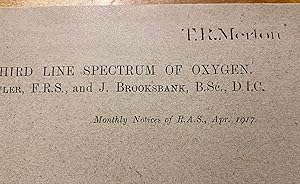Fowler Third Line Spectrum Oxygen by Merton Thomas Ralph (1 results)
FeedbackSearch filters
Product Type
- All Product Types
- Books (1)
- Magazines & Periodicals (No further results match this refinement)
- Comics (No further results match this refinement)
- Sheet Music (No further results match this refinement)
- Art, Prints & Posters (No further results match this refinement)
- Photographs (No further results match this refinement)
- Maps (No further results match this refinement)
- Manuscripts & Paper Collectibles (No further results match this refinement)
Condition
- All Conditions
- New (No further results match this refinement)
- Used (1)
Binding
- All Bindings
- Hardcover (No further results match this refinement)
- Softcover (1)
Collectible Attributes
- First Edition (No further results match this refinement)
- Signed (No further results match this refinement)
- Dust Jacket (No further results match this refinement)
- Seller-Supplied Images (1)
- Not Print on Demand (1)
Language (1)
Price
- Any Price
- Under £ 20 (No further results match this refinement)
- £ 20 to £ 35 (No further results match this refinement)
- Over £ 35
Free Shipping
- Free Shipping to United Kingdom (No further results match this refinement)
Seller Location
Seller Rating
-
A. Fowler, "The THird Line Spectrum of Oxygen", offprint from Monthly Notices of the R.A.S.
Publication Date: 1917
Seller: JF Ptak Science Books, Hendersonville, NC, U.S.A.
£ 76.91
Convert currency£ 25.39 shipping from U.S.A. to United KingdomQuantity: 1 available
Add to basketSoft cover. Condition: Fine. Offprint; original wrappers. Fine copy. Pp 311-317. Stamped "T.R. Merton" in the upper right corner. [++] "Sir Thomas Ralph Merton KBE, DSc, FRS (12 January 1888 10 October 1969) was an English physicist, inventor and art collector. He is particularly noted for his work on spectroscopy and diffraction gratings. After 1913 a steady stream of papers came from Merton's private laboratory, in which he assembled the latest spectroscopic equipment. His early work was on the absorption spectra of solutions, but he soon changed to the spectra of gases and to astrophysics, which were to be the main fields of his investigations. His early papers were distinguished by the beauty and accuracy of his experimental techniques. In 1916 he obtained his DSc from Oxford and was appointed lecturer in spectroscopy at King's College London. In the same year his first joint paper with his friend J. W. Nicholson appeared. It was a fortunate chance which brought together Nicholson's brilliant mathematical analysis and Merton's experimental skill. The paper dealt with the broadening of spectral lines in a condensed discharge. By an ingenious technique Merton measured the discontinuities in the lines due to their partial breaking up into components under the influence of the magnetic field between adjacent atoms. The two men applied the same technique to the measurement of the spectra of hydrogen and helium, reproducing the distribution of intensity of some stellar lines in the laboratory for the first time."--Wikipedia (via the Royal Society publishing site, though unattributed) T.R. Merton was also the FIRST "Q" of MI6 (according to Sotheby's, which auctioned a great Renaissance masterpiece once owned by Merton).


